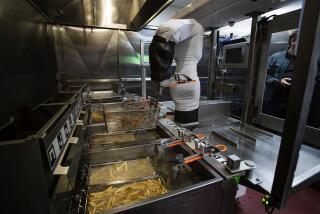Equipois’ robotic limbs give factory workers and others a hand
- Share via
At the Ford Motor Co. truck plant in Louisville, Ky., massive, 800-pound robotic arms used for bolting together parts are being replaced by slender, futuristic-looking limbs that can be controlled by a finger.
The new arms — just a quarter of the size, weight and price of the machines they are replacing — have already helped reduce injuries and may allow Ford to speed up assembly.
“Now that there’s this lightweight, cheaper arm, we’re able to put them on a lot more tools and help more operators,” said Allison Stephens, a Ford ergonomics specialist.
The automaker has bought 10 arms and is looking at buying more. That is good news for Equipois Inc., the small Playa Vista company that developed the robotic limb based on a technology first made famous in Hollywood.
The zeroG exoskeletal arm, resembling a limb that might have fallen off the Terminator, shares its roots with the Steadicam, which has revolutionized the way action movies are shot.
Equipois sees the same technology helping sculptors, surgeons and dentists work longer without getting tired. A new version of the mechanical arm, the x-Ar, attaches to a chair and holds up your human arm to alleviate strain. With the x-Ar, a sculptor would be able to chisel away indefinitely; without it the arm would need to rest after about 10 minutes, founder Eric Golden said.
The company, founded four years ago, has some high-profile financial backers including Patrick Soon-Shiong, a billionaire investor and entrepreneur, who said he is excited about the technology’s prospects, from its use in medicine and perhaps even in warfare.
Equipois will have “worldwide applications, whether in the workplace or whether actually transforming health or even in military operations,” Soon-Shiong said.
The company was founded by Golden, an attorney before he got a job working in the mergers and acquisitions unit for Panavision Inc., the Woodland Hills-based maker of movie cameras and equipment.
With fresh eyes to the movie industry, Golden, 43, was impressed not by what he saw on the silver screen but by the industry’s technologies and their potential outside of the studio.
“People in entertainment, on film sets and TV sets in particular, are called upon to solve creative problems very quickly, and they do so with a real ingenuity and resourcefulness,” he said. “Because I was new, I kept thinking of what else this sort of technology could be used for.”
He found his answer when he ran into Garrett Brown, the inventor of the Steadicam.
Brown, 69, had been approached by Honda Motor Co. to see if the Steadicam’s technology could be used to improve its factory work.
“That fit my model perfectly, and we both realized right away that this had some real potential,” Golden said.
In 2008, Equipois rolled out its first product: the zeroG, which helps factory workers operate heavy tools.
“It turns out it does more than just stabilize,” said Brown, the Steadicam inventor. “It’s an elegant and effortless way to hold an object, whether it’s a tool or a camera.”
Equipois’ zeroGs cost $5,000 or $10,000, depending on how much weight they can hold. The company has sold about 500 arms, mostly of the $10,000 model, to a list of clients that include Boeing Co., General Electric Co., Ford and Lockheed Martin Corp., as well as the Air Force and the Navy. The military uses the arms for maintaining aircraft.
After surpassing the $1-million revenue mark in 2010, Equipois is expected to bring in $4 million to $5 million in 2011, Golden said. The company expects to turn a profit in late 2012.
Equipois has raised about $10 million from investors, employs about 30 people and is less than a month from shipping its second product line.
The x-Ar, which costs $3,500, is like the zeroG, but rather than making heavy tools feel lighter, the x-Ar gives humans more strength and endurance.
“We are very lucky to have this mission that involves helping people,” Golden said. “It also is nice to have a very cool technology to do it with.”
In the future, Equipois hopes to offer full body exoskeleton suits to assist the elderly and disabled, and that average people can afford and use. It is already working with big companies in the defense sector to provide arms for exoskeleton suits.
Military expert Peter W. Singer, author of “Wired for War,” a book about robotic warfare, said the exoskeleton business is in its early stages but already has many looking to make the breakout device.
“What tends to play out with humans is we first focus on replacement and then we get to enhancement,” Singer said. “The same technology that might help a sicker person lift weight that they couldn’t might also be looked at by someone else as a technology that will help them lift 400 pounds without breaking a sweat.”
Though evil Hollywood robots aren’t the inspiration for Equipois’ products, they do hold similarities.
“Those things can be a little overwhelming, but it’s the same idea,” he said. “It’s using machines to make people stronger, safer and have more stamina.”
More to Read
Inside the business of entertainment
The Wide Shot brings you news, analysis and insights on everything from streaming wars to production — and what it all means for the future.
You may occasionally receive promotional content from the Los Angeles Times.











